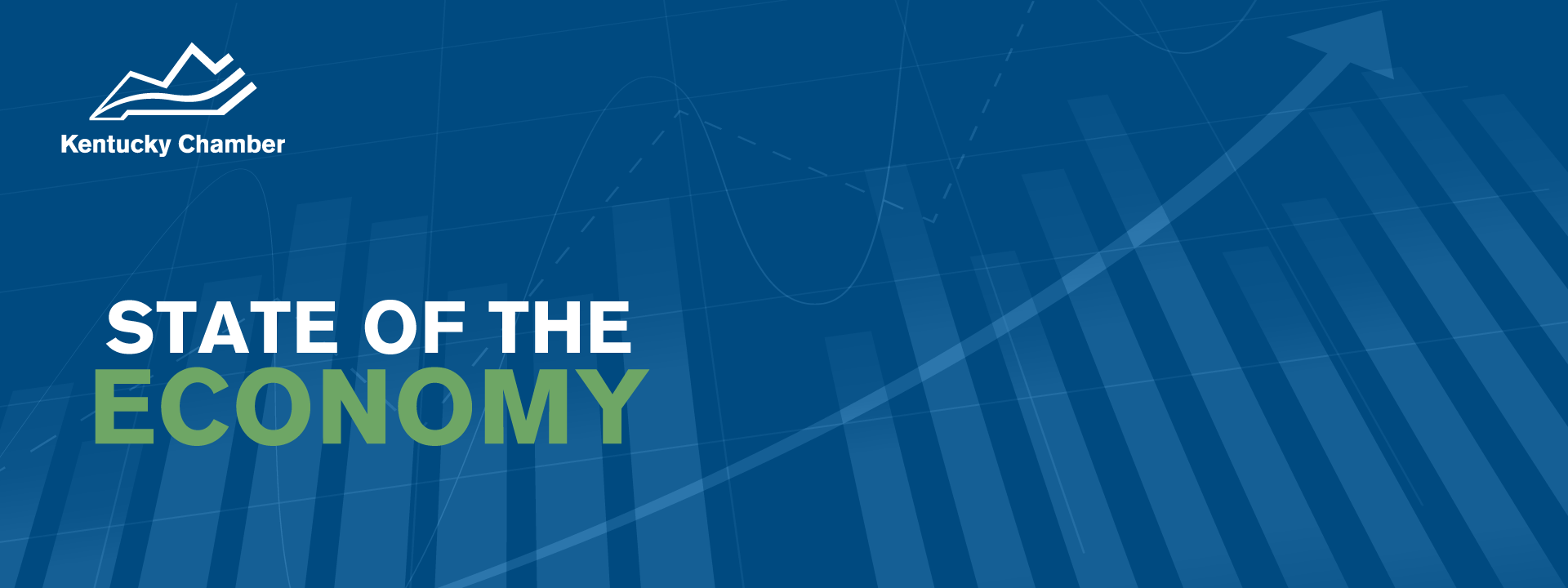Five Things to Know About The Economy
The government shutdown resulted in an absence of recent data, somewhat clouding our understanding of current economic conditions. Available data show that the rates of hiring, job growth and employment have improved in Kentucky compared to the US; however, there are still signs of “cooling” in the labor market. Inflation in the US continues to be above the Federal Reserve’s target rate and has accelerated since the spring. Below are five quick facts about the economy with objective data and context.
Here are five things to know about the economy as of November 24, 2025.
Job Growth
Kentucky has avoided the recent slowdown in national job growth, so far.
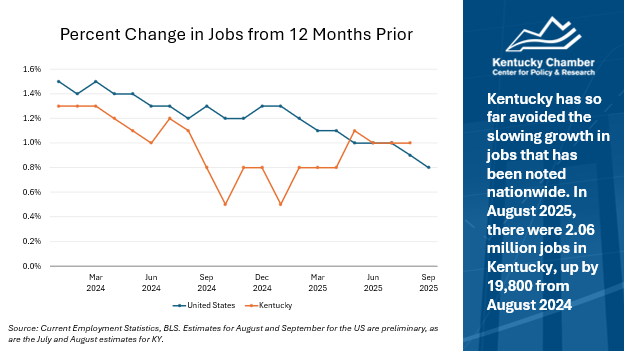
- Measuring the 12-month change in jobs as a percentage allows more direct comparisons of KY and US job growth and naturally removes the seasonality of month-to-month changes.
- The positive changes in jobs seen in KY recently and slowing growth in the US are consistent with a narrowing gap in unemployment and employment-to-population (see charts below).
Unemployment
Unemployment gap between the U.S. and Kentucky has narrowed recently.

- Unemployment is defined as not being employed and actively searching for a job. People who don’t have jobs and are not actively searching are counted as being out of the labor force.
- The unemployment rate can fall or rise as people have an easier or harder time finding a job; but it can also fall if people without jobs leave the labor force or rise if more people enter the labor force. This is why we should also look at other metrics – like employment-to-population ratios (see below) – to understand changes in the unemployment rate.
Employment and Hiring
Employment in Kentucky has risen, while it has fallen nationally.
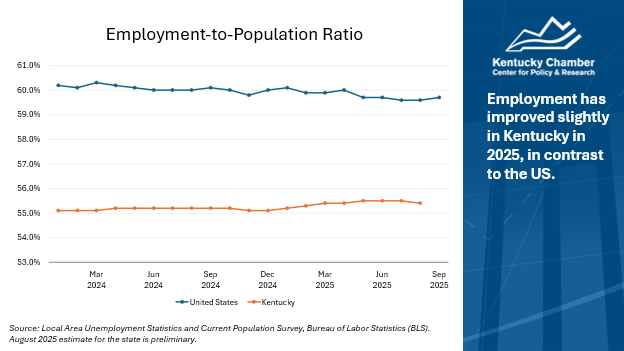
- The employment-to-population ratio (# employed as percent of population 16 years and older) rose slightly in Kentucky from January to August 2025, while falling some nationwide.
- This dynamic suggests that the changes in unemployment rates were driven by changes in the numbers of people losing and finding jobs.
- Employment rates in the U.S. are generally higher than in Kentucky, as is labor force participation. Inside Kentucky, employment and labor force participation rates are much lower in counties that are outside of metropolitan areas than in metro areas.
Layoffs
Hiring is slowing in both Kentucky and the U.S., as layoffs and quits hold steady.
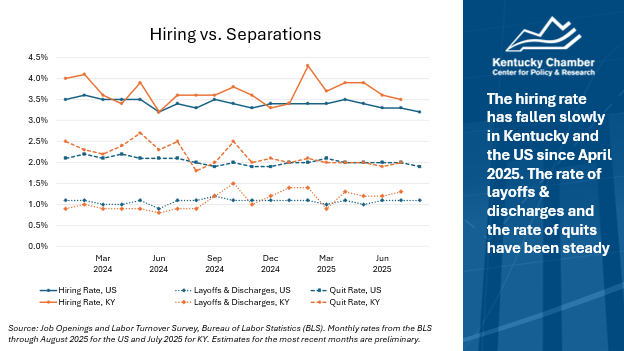
- Recent media stories of mass layoff announcements (e.g., 48,000 nationwide from UPS and 14,000 from Amazon) have provoked more concern than is warranted. Hard economic data suggests layoff activity remains within normal bounds.
- Overall, however, the evidence is consistent with a slow cooling of the labor market in both Kentucky and the US. Hiring has deteriorated slowly (at least through August) as layoffs and discharges have held steady. Firms appear less willing to hire, but also reluctant to make major changes.
- Slowing hiring likely explains at least some of the increase in the national unemployment rate.
Inflation
Inflation has shown signs of acceleration recently.
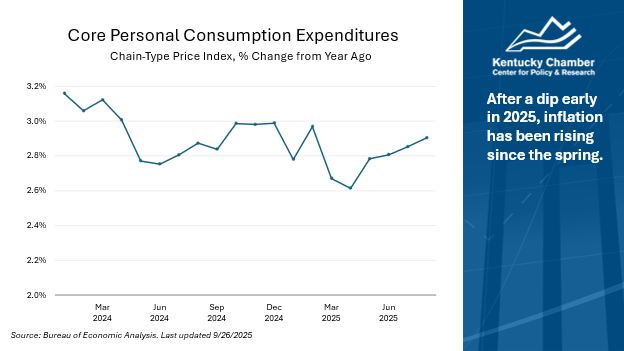
- The Fed targets 2% inflation using the Core PCE, which excludes energy and food. The US has not met this target since 2021.
- The increase in inflation shown since April 2025 is consistent with the effects of tariffs; however, those effects were very likely blunted by the anticipatory increase in imports earlier in the year. Firms appear reluctant to raise prices until they run through the inventories they accumulated earlier. It is possible that many are hoping they can wait out the worst of the tariffs and import more after deals are struck or the Supreme Court rules.
About This Data
On this web page, we provide economic updates on Kentucky and the United States, using a range of key metrics from the U.S. Department of Labor, U.S. Bureau of Economic Analysis, the University of Michigan, the St. Louis Federal Reserve, and the U.S. Chamber of Commerce. All data is analyzed by the Kentucky Chamber Center for Policy and Research. On this page, we cover jobs, unemployment, unemployment insurance claims, hiring, workforce participation, inflation, consumer sentiment, and small business optimism.
Sources
Federal Reserve Bank of St. Louis, Federal Reserve Economic Data
MetLife and U.S. Chamber of Commerce, Small Business Index
University of Michigan, Survey Research Center, Surveys of Consumers
U.S. Bureau of Economic Analysis, Personal Consumption Expenditures Price Index
U.S. Bureau of Labor Statistics, Local Area Unemployment Statistics
U.S. Bureau of Labor Statistics, Labor Force Statistics from the Current Population Survey
U.S. Department of Labor, Employment and Training Administration, Unemployment Insurance Data
U.S. Federal Reserve, Economy at a Glance – Inflation (PCE)
ADP Employment Report
Carlyle
Revelio Labs
U.S. Tariffs on Track to Hit 84-Year High Under Current Proposals, Tax Foundation Says
The Kentucky Chamber hosted a webinar on June 9, 2025, featuring Vice President of Policy Charles Aull and Erica York, Vice President of Federal Tax Policy at the Tax Foundation, to explore how tariff and tax policies in Washington are shaping the economic landscape for Kentucky businesses.
Watch the webinar below:
